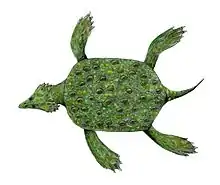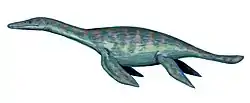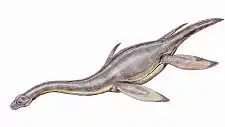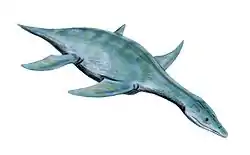Opallionectes
Opallionectes andamookaensis (meaning "the opal swimmer from Andamooka") is the name given to a 5 m (16 ft) long plesiosaur, which is thought to have lived during the early Cretaceous period (Lower middle Aptian), 115 million years ago, in shallow seas covering what is now Australia.
| Opallionectes | |
|---|---|
| Scientific classification | |
| Kingdom: | |
| Phylum: | |
| Class: | |
| Order: | |
| Suborder: | |
| Family: | |
| Genus: | Opallionectes Kear 2006 |
| Species | |
| |
Description
An opalized partial skeleton (including vertebrae, ribs, limb elements, teeth, and associated gastroliths) of the animal has been discovered in an opal mine in the Bulldog Shale at Andamooka in South Australia and described by Kear in 2006.[1] It had fine needle like sharp teeth similar to those of nothosaurs and were probably used to trap small prey such as fish and squids. It is considered a sort of missing link between the much older plesiosaurs, living 165 million years ago, and the ones near the end of the Cretaceous, 66 million years ago, between which there had been a gap in the fossil record. Analyses of the sedimentary structures, fossils, isotope data and climatic modeling show that Opallionectes lived in a region characterized by seasonally cold (possibly freezing) conditions, suggesting that it had developed some adaptation to live in cold water, such as seasonal migration or elevated metabolism.
References
- Kear, 2006
Bibliography
- Kear, Benjamin P. 2006. Marine reptiles from the Lower Cretaceous of South Australia: elements of a high‐latitude cold‐water assemblage. Palaeontology 49. 837–856. Accessed 2020-07-02.






.png.webp)
